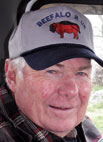
In Wright County, near Norwood, Mo., Eugene Ussery raises Beefalo cattle on his 322-acre farm. At the present time he has 150 head of Beefalo.
Eugene explained that to be a Beefalo, the animal “has to have at least 17 per cent bison in them.” He said, “That’s what it takes to be called a Beefalo. It can be up to 37.5; that’s full-blooded, 35.156 percent is a purebred. They can have any beef breed in their ancestry. They can be Charolais, Limousin, Hereford, Angus, or whatever. That’s why there is no breed color.”
He is often asked if he has buffalo. He said people ask if he uses a buffalo bull or a buffalo cow. His response is simple. He tells them, “We have Beefalo bulls and Beefalo cows and they make Beefalo calves.”
Many years ago, when Eugene was away from this area, he heard about Beefalo and thought they sounded interesting. He came home in 1976 and ran a dairy operation for 25 years.
Eugene said, “I’d ask people about Beefalo and they’d never heard of them. As soon as I quit milking, I read an article about a herd (of Beefalo). First of all you have an animal that tends to have smaller calves, so you really don’t have a calving problem. Secondly, they’re hardier than regular beef.”
He explained, “They have an extra thick hair coat so they can withstand the winter weather better.” He’s been told the Beefalo have as much as 30 percent more hair. “Which means they can really keep warmer. You don’t see them out all humped up like some breeds in the cold winter weather,” Eugene stated.
He said, “They’ve also got sweat glands, like the buffalo or bison, so they can withstand the heat in the summertime better. That’s from the producer’s point of view.” He also explained the benefits from the consumer’s point of view. “You get a meat that is leaner, has a lot less calories, fat and cholesterol.”
After reading about Beefalo, Eugene went and looked at some. He said, “They just look like regular cattle, and are just as domesticated.”
Eugene didn’t gently wade into the Beefalo business. He stated, “We bought in pretty good size because we decided to be completely out of the dairy business. We bought 27 cows that had 13 calves on them, and we bought 20 heifers. So we bought a total of 60 head when we started in May of 2001 and we’ve gone from there.” He added, “They just appealed to us from the beginning.”
Not buying another cow after that initial purchase, Eugene has a closed herd. He has kept the heifers, and stated, “The only thing I’ve brought in has been bulls.” If he were going to buy more Beefalo cows, Eugene said, “I’d look for normal size. You don’t need them extra big. I’ve found out they may look nice, but they eat more and are more apt to break down. I’d look for width in the hips, so they wouldn’t have calving problems.”
While he didn’t say any particular breed of cattle does better when crossed with buffalo, Eugene did say, “I’ve got several light colored ones, which indicates to me a Charolais influence in there somewhere. But I have blacks, reds, grays and everything else.”
He stressed, “The one thing you want to watch for more than anything else with Beefalo is don’t get any particular breed that’s a little lighter in the hindquarters.” Eugene explained, “The hindquarters is where the buffalo is the lightest.” He added, “What they like to say about the Beefalo is they’ve taken off the hump and put it on the rump. In other words, they’ve put the meat back there on Beefalo, because buffalo didn’t have it back there. He’s just got the big hump and he’s a little light.”
He recommended, “There are different breeds of beef animals that are heavier back there and probably work better. I’ve been told that Gelbvieh would probably work real well. I’ve been tempted to do a little crossing that way, just to see.”
Eugene prefers to sell his cattle to individuals. He said, “We will sell them as soon as they’re weaned.” He will sell steers for butchering, heifers for reproduction, or cows. Ussery Beefalo also sells state inspected packaged meat. Eugene described, “It’s a little different texture. It’s not gamey at all. It’s not marbled up like Black Angus; you don’t have a lot of fat in it.”
While he does and will sell locally, he said, “I sell more of my meat to people 50 miles away.”







